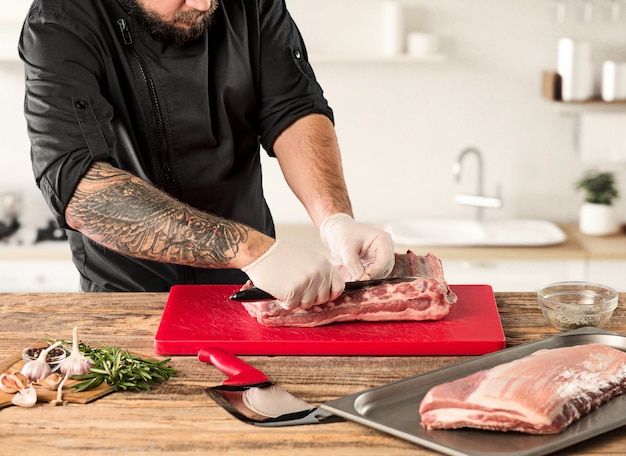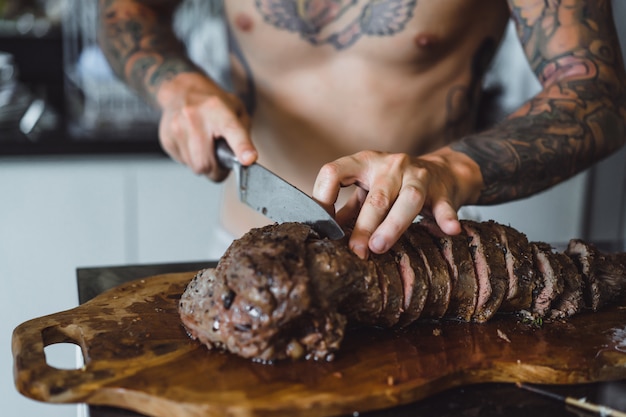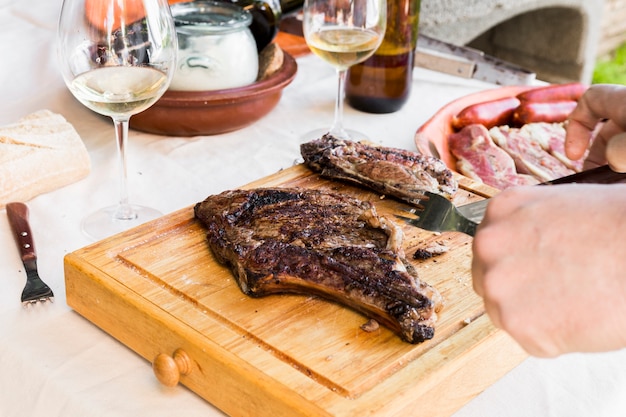You've got a 5lb prime rib roast in your sights, haven't you? The anticipation of that glistening, perfectly cooked cut, the aroma that fills your kitchen, the 'oohs' and 'aahs' from your guests – it's all worth it. But let's be honest, tackling a prime rib roast can feel a little daunting, right? There's a lot of pressure to get it right, and a lot of time and effort involved. Fear not, my friend, because I'm here to guide you through the process with all my tips, tricks, and (admittedly) a few lessons learned from past mishaps. Let's get this feast started!
(Part 1) choosing the right cut – Your Prime Rib Foundation

Before you even think about the oven, you need the right foundation: the perfect prime rib cut. And when it comes to prime rib, the star of the show is undoubtedly the standing rib roast. It's the classic choice for a reason – it's simply stunning. A 5lb standing rib roast is a great size for a crowd, easily feeding 8-10 people. Now, before you head to the butcher, let's talk about a few key considerations:
Bone-In vs. Boneless: What’s Your Style?
A bone-in roast brings more than just flavour – it adds a visual element that makes it look truly spectacular. The bone helps to keep the meat moist during cooking, lending that beautiful, melt-in-your-mouth texture. If you're aiming for elegance, a bone-in roast is the way to go. However, if you're looking for a more straightforward experience, a boneless roast is easier to carve and tends to cook more evenly. It's a great option for beginners, but it does lack that visual wow factor.
Rib Count: How Much is Enough?
The rib count impacts the size and shape of your roast, so it's worth thinking about how many you're planning on feeding. A 3-4 rib roast is a good choice for a smaller gathering, while a 7-8 rib roast will feed a larger crowd. Personally, I'm a sucker for a good 7-rib roast – it just has that classic prime rib look. It’s all about what suits your table!
Marbling: The Secret to Juiciness
Marbling, those streaks of fat throughout the meat, is the key to achieving a juicy, flavourful prime rib. Look for a roast with good marbling – it's your guarantee for a tender, melt-in-your-mouth experience. Don't be afraid of a bit of fat; it's your friend when it comes to prime rib. Trust me, you'll thank me later!
(Part 2) Preparing the Roast: Building Flavour

Alright, you've got your perfect cut. Now it's time to get creative. This is your chance to add flavor and create that beautiful, crispy crust. It's all about bringing out the best in your prime rib!
Seasoning: Your Personal Touch
Don't be shy with the seasoning, but don't go overboard either. Here's my go-to seasoning recipe, which I've perfected over years of prime rib adventures:
Basic Seasoning Recipe:
- Salt: Use kosher salt, about 1 tablespoon per pound of meat. This is crucial for drawing out moisture, so don't skimp.
- Pepper: Freshly ground black pepper, about 1 teaspoon per pound of meat. Always use freshly ground pepper, it makes a world of difference.
- Garlic Powder: About 1/2 teaspoon per pound of meat. A little garlic goes a long way in adding that satisfying savory note.
- Onion Powder: About 1/2 teaspoon per pound of meat. Onion powder adds a depth of flavour that really elevates the whole roast.
- Dried Herbs: Rosemary, thyme, or oregano are all fantastic choices, about 1 teaspoon per pound of meat. Experiment and find your favourite combination.
You can rub this mixture directly onto the roast, but I prefer to create a paste. Mix all the ingredients with a tablespoon or two of olive oil to form a thick paste. This ensures the spices adhere beautifully to the meat and the seasoning is even. It's a simple trick, but it makes a big difference!
roasting time: Timing is Everything
A 5lb prime rib roast will need around 2-3 hours in the oven, depending on how you like your meat. But remember, these are just guidelines. The actual roasting time will vary based on your oven and the thickness of the roast. Here's a basic guide for roasting times, but don't be afraid to adjust based on your preferences:
| Desired Doneness | internal temperature | Roasting Time |
|---|---|---|
| Rare | 125-130°F | 2-2.5 hours |
| Medium Rare | 130-135°F | 2.5-3 hours |
| Medium | 135-140°F | 3-3.5 hours |
| Medium Well | 140-145°F | 3.5-4 hours |
| Well Done | 145-150°F | 4-4.5 hours |
The key is to use a meat thermometer to check the internal temperature of the roast. It's the only way to know for sure when it's reached your desired level of doneness.
(Part 3) Cooking Methods: Choosing Your Approach

Now for the fun part – deciding how to cook your prime rib masterpiece! Each method has its own advantages and drawbacks, so choose the one that best suits your style and time constraints.
The Classic Oven Roast: Simple and Satisfying
This is the go-to method for a reason. It's simple, straightforward, and delivers delicious results. Preheat your oven to 450°F, place the roast in a roasting pan, and let it cook for 15 minutes per pound. After that, reduce the oven temperature to 325°F and continue cooking until the roast reaches your desired internal temperature.
Here's a little tip I've learned over the years: add a splash of water to the bottom of the pan. It creates steam, which helps keep the roast moist and tender. It’s a subtle trick, but it makes a difference!
reverse searing: The Master of Even Cooking
This method involves cooking the roast at a low temperature for a longer period, followed by a quick sear at a high temperature. This results in a more evenly cooked roast with a crispy crust. It’s a bit more time-consuming, but the results are worth it.
Preheat your oven to 225°F and place the roast in a roasting pan. Cook for 2-3 hours, or until the internal temperature reaches 125-130°F for rare. Then, crank up the oven to 450°F and sear the roast for 10-15 minutes. The low-and-slow cooking ensures even cooking throughout, while the searing adds that perfect crispy exterior. It's a winning combination!
The Smoking Method: A Symphony of Flavour
This one requires a bit of commitment, but if you've got the time and the smoker, it's a game changer. Preheat your smoker to 225°F and smoke the roast for 2-3 hours, or until it reaches 125-130°F for rare. Then, remove it from the smoker and wrap it tightly in aluminum foil. Let it rest for 30 minutes before slicing and serving.
The smoky flavour achieved through this method is truly special. Use wood chips that pair well with beef, like hickory or mesquite, for an extra touch of flavour. You'll be amazed by the results!
(Part 4) Resting and Carving: The Art of Patience
You've done the hard work. Now, it's time to let the roast rest. This is crucial for allowing the juices to redistribute throughout the meat, preventing it from drying out. Let the roast rest for at least 15-20 minutes before carving. Patience is key here!
Carving a prime rib roast can seem daunting, but it's actually quite straightforward. Use a sharp carving knife and a carving fork for the best results. Start by slicing the meat against the grain, which means slicing perpendicular to the muscle fibers. This ensures the meat is tender and easy to chew.
If you're serving a bone-in roast, start by carving the meat from the thickest part of the roast and work your way down to the bone.
(Part 5) Serving Suggestions: A Feast for the Senses
The moment you've been waiting for: plating up your prime rib masterpiece! Here are some classic side dish ideas to complete your feast and create a truly memorable dining experience.
Sides to Compliment the Roast:
- Roasted Potatoes: A classic for a reason! Simple roasted potatoes, crispy on the outside and fluffy on the inside, are a perfect complement to the rich flavour of prime rib.
- mashed potatoes: Rich, creamy, and a wonderful contrast to the hearty prime rib. Mashed potatoes add a touch of elegance and comfort to your meal.
- Creamed Spinach: A velvety green side dish that adds a touch of elegance to the table. The creamy texture provides a nice contrast to the roast.
- Asparagus: Roasted or grilled asparagus spears bring a fresh and vibrant touch to the plate, balancing the richness of the prime rib.
- Yorkshire Pudding: A traditional British side dish that's crispy on the outside and fluffy on the inside, perfect for soaking up all that delicious gravy. It's a true classic pairing for prime rib.
Of course, no prime rib meal is complete without the perfect gravy!
(Part 6) Making the Perfect Gravy: The Finishing Touch
A good gravy can truly elevate your prime rib meal to a whole new level. It's that magical ingredient that brings all the flavours together and makes your guests say "Wow!". Here's how to create a simple yet delicious gravy that will impress everyone:
Basic Gravy Recipe:
- Deglaze the Pan: Once the roast is out of the pan, add a tablespoon of butter to the pan and let it melt. Pour in a cup of red wine or beef broth and scrape up all the delicious bits from the bottom of the pan. This is where all the flavour is concentrated!
- Thicken the Gravy: Whisk in a tablespoon of cornstarch or flour and cook until the mixture thickens. This creates a velvety texture that coats the prime rib perfectly.
- Season: Season the gravy with salt, pepper, and any other herbs or spices you like. This is your chance to add your personal touch and make the gravy truly unique.
- Strain the Gravy: Strain the gravy through a fine-mesh sieve to remove any lumps. A smooth, lump-free gravy is a must!
- Serve: Pour the gravy over the roast and enjoy! It's that simple.
Feeling extra fancy? Try adding a splash of Worcestershire sauce to your gravy for a touch of umami flavour that will have your guests begging for more.
(Part 7) Leftovers: Don't Waste a Single Bite
Let's face it, you're probably going to have some leftovers. And that's a good thing! Those prime rib leftovers are begging to be transformed into delicious meals. Here are some ideas to make the most of them:
Leftover Prime rib recipes:
- Prime Rib Sandwiches: Slice the leftovers and pile them high on crusty bread with some gravy, cheese, and your favourite toppings. It's a hearty and satisfying sandwich that's perfect for lunch or dinner.
- Prime Rib Hash: Dice up the leftover meat and sauté it with onions, peppers, and potatoes. It’s a great way to use up those leftovers and create a flavorful and hearty breakfast or brunch.
- Prime Rib Soup: Add the leftover meat to a hearty soup with vegetables and broth. It's a comforting and satisfying meal that's perfect for a cold day.
But remember, keep those leftovers in the fridge for no more than 3-4 days. After that, it's time to say goodbye.
(Part 8) FAQs
Q: What's the best temperature for cooking a prime rib roast?
A: The ideal temperature for cooking a prime rib roast depends on how you like your meat. For rare, aim for 125-130°F. For medium rare, go for 130-135°F. For medium, aim for 135-140°F. And for well done, 145-150°F. These are just guidelines, and the actual temperature may vary slightly depending on your oven and the thickness of the roast.
Q: Can I cook prime rib in a slow cooker?
A: It's not recommended to cook prime rib in a slow cooker. A slow cooker isn't ideal for achieving the crispy crust and juicy interior you want from a prime rib roast. Slow cookers are better suited for tougher cuts of meat that need to be cooked slowly to break down connective tissue.
Q: How long should I let the prime rib rest before carving?
A: It's essential to let the roast rest for at least 15-20 minutes before carving. This allows the juices to redistribute throughout the meat, preventing it from drying out.
Q: What are some tips for carving a prime rib roast?
A: Use a sharp carving knife and a carving fork. Start by slicing the meat against the grain, which means slicing perpendicular to the muscle fibers. This helps ensure that the meat is tender and easy to chew.
Q: How long can I store leftover prime rib in the refrigerator?
A: You can store leftover prime rib in the refrigerator for 3-4 days. Be sure to wrap it tightly in plastic wrap or aluminum foil to keep it fresh.
Everyone is watching

Prime Rib Roast Cooking Time Chart: Per Pound Guide
Cooking TipsPrime rib roast. Just the name conjures images of lavish dinners, crackling fires, and hearty laughter. It’s ...

How Long to Bake Potatoes in the Oven (Perfect Every Time)
Cooking TipsBaked potatoes are a staple in my kitchen. They're incredibly versatile, delicious, and surprisingly easy to m...

Perfect Rice Every Time: The Ultimate Guide to Cooking Rice
Cooking TipsAs a self-proclaimed foodie, I've always been a bit obsessed with rice. It's the foundation of countless cuisi...

The Ultimate Guide to Cooking Asparagus: Tips, Techniques, and Recipes
Cooking TipsAsparagus. The mere mention of this spring delicacy conjures up images of vibrant green spears, crisp and burs...

Ultimate Guide to Cooking the Perfect Thanksgiving Turkey
Cooking TipsThanksgiving. Just the word conjures up images of overflowing tables laden with delicious food, the scent of r...
